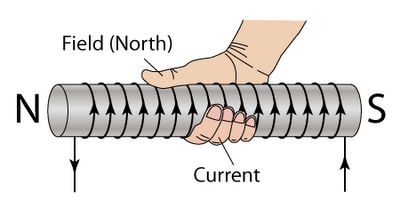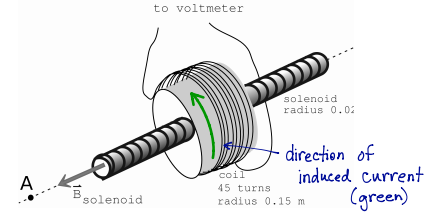Magnetic Field of a Solenoid Using Ampere's Law: Difference between revisions
mNo edit summary |
m (Typos) |
||
| Line 8: | Line 8: | ||
[[File:solenoidfrombook.png]] | [[File:solenoidfrombook.png]] | ||
As you can see in this model, at the ends of a solenoid the magnetic field begins to point outward at angles from the axis, with some of the field pointing directly perpendicular. In | As you can see in this model, at the ends of a solenoid the magnetic field begins to point outward at angles from the axis, with some of the field pointing directly perpendicular. In the middle, however, the field is constant throughout the entirety of the interior and is parallel to the axis. | ||
===A Mathematical Model=== | ===A Mathematical Model=== | ||
If there are <math>N</math> loops of wire | If there are <math>N</math> loops of wire that compose a solenoid of length <math>L</math>, and we know that Ampere's Law for Magnetism gives us the form: | ||
<math>{\oint\,\vec{B}•d\vec{l} = μ_{0}∑I_{inside path}}</math> | <math>{\oint\,\vec{B}•d\vec{l} = μ_{0}∑I_{inside path}}</math> | ||
| Line 40: | Line 40: | ||
===Simple=== | ===Simple=== | ||
Find the magnetic field produced by | Find the magnetic field produced by a 40 cm long solenoid if the number of loops is 400 and current passing through it is 5 A. | ||
[[File:Examplesolenoid.jpg|700x900px]] | [[File:Examplesolenoid.jpg|700x900px]] | ||
| Line 62: | Line 62: | ||
[[File:hardb.jpg|700x900px]] | [[File:hardb.jpg|700x900px]] | ||
c.) At time t = 0.3 seconds, what is the magnitude of the non-coulomb electric field | c.) At time t = 0.3 seconds, what is the magnitude of the non-coulomb electric field E<sub>NC</sub> in | ||
the coil? | the coil? | ||
[[File:hardc.jpg|700x900px]] | [[File:hardc.jpg|700x900px]] | ||
| Line 68: | Line 68: | ||
==Connectedness== | ==Connectedness== | ||
#Solenoids are important because they are the easiest way to create electromagnets and are an important piece in transformers. | #Solenoids are important because they are the easiest way to create electromagnets and are an important piece in transformers. | ||
#As a Computer Engineering major solenoids are important, at least for the EE parts of my major, because as stated above they are used to create transformers which are a major piece in large and small scale power grids. | #As a Computer Engineering major, solenoids are important, at least for the EE parts of my major, because as stated above they are used to create transformers which are a major piece in large and small scale power grids. | ||
Revision as of 12:53, 26 April 2016
---- CREATED BY JAKE WEBB ----
This page explains how to use Ampere's Law to solve for the magnetic field of a solenoid.
The Main Idea
A solenoid is a long coil of wire with a very small diameter, often used to make electromagnets due to their ability to create strong magnetic fields. The magnetic field can be easily calculated along the axis of the solenoid using Ampere's Law, and the magnitude and direction of the field is constant throughout the entirety of the solenoid, excluding the ends.
As you can see in this model, at the ends of a solenoid the magnetic field begins to point outward at angles from the axis, with some of the field pointing directly perpendicular. In the middle, however, the field is constant throughout the entirety of the interior and is parallel to the axis.
A Mathematical Model
If there are [math]\displaystyle{ N }[/math] loops of wire that compose a solenoid of length [math]\displaystyle{ L }[/math], and we know that Ampere's Law for Magnetism gives us the form:
[math]\displaystyle{ {\oint\,\vec{B}•d\vec{l} = μ_{0}∑I_{inside path}} }[/math]
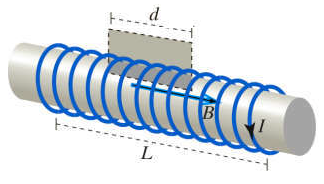
As stated above, the magnetic field inside a solenoid is constant and parallel to [math]\displaystyle{ dl⃗ }[/math], therefore Ampere's Law can be simplified to:
[math]\displaystyle{ BL=μ0NI }[/math]
By simply solving for [math]\displaystyle{ B }[/math] we can find the equation for the magnetic field of a solenoid:
[math]\displaystyle{ {B = \frac{μ_{0}NI}{L}} }[/math]
The direction can be found using the Right Hand Rule with your fingers curling around in the direction of the current and your thumb pointing in the direction of the magnetic field. It will always be along the axis for a solenoid.
A Computational Model
This gif shows how the magnetic field forms in the solenoid when there is a current running through it.

Examples
Simple
Find the magnetic field produced by a 40 cm long solenoid if the number of loops is 400 and current passing through it is 5 A.
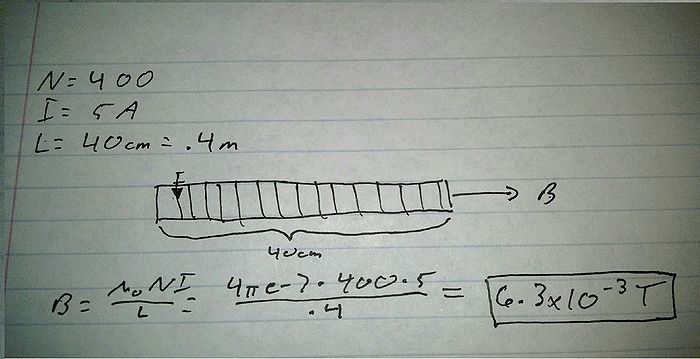
This example is very simple, as all of the variables of the equation are provided. All you need to do is plug them in and find the direction using the right hand rule.
Middling
A solenoid has a magnetic field of 5x10-4 T, 3000 turns, and is 30 cm long. What is the current through the solenoid?
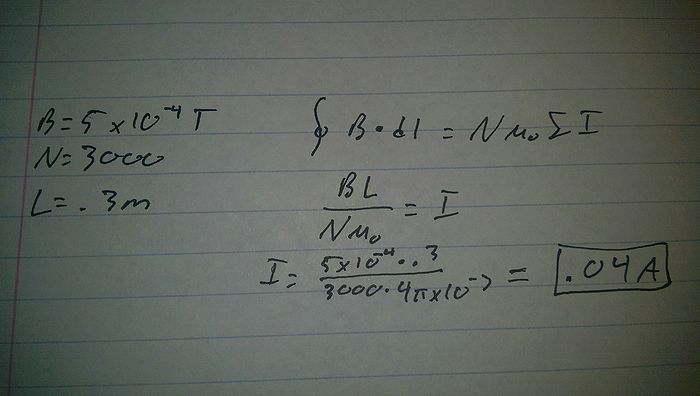
This example is just a reverse solving of the equation derived above for the magnetic field of a solenoid. It is not munch more difficult than the previous example.
Difficult
A long, tightly wound solenoid has a circular cross section of radius 0.02 m. The solenoid is connected to a power supply (not shown), and this current changes with time, so the magnetic field inside the solenoid also changes with time. At time t = 0 s, the magnitude of the magnetic field inside the solenoid is 1.8 T. At time t = 0.3 s, the magnitude of the magnetic field inside the solenoid is 0.5 T. The direction of the magnetic field inside the solenoid is shown in the diagram. The solenoid passes through a coil of wire, which has 45 turns of radius 0.15 m. The coil is connected to a voltmeter (not shown).
a.) At the same instant (t = 0.3 seconds), what will the absolute value of the reading on the voltmeter be?
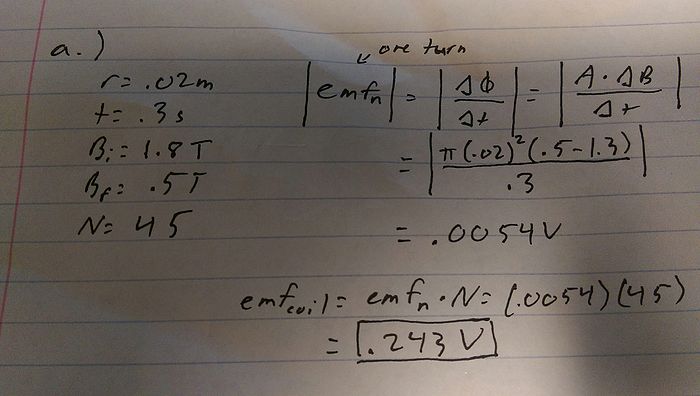
b.) The resistance of the coil is 2 ohms. At time t = 0.3 seconds, what is the conventional current in the coil?
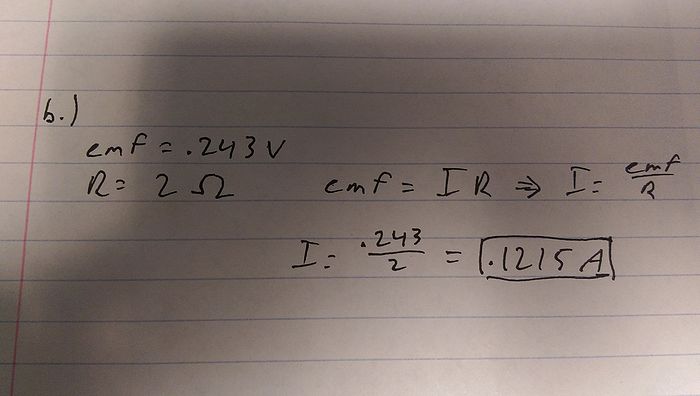
c.) At time t = 0.3 seconds, what is the magnitude of the non-coulomb electric field ENC in the coil?
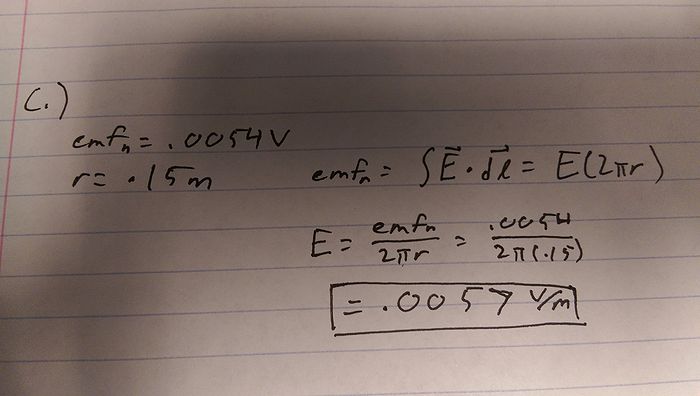
Connectedness
- Solenoids are important because they are the easiest way to create electromagnets and are an important piece in transformers.
- As a Computer Engineering major, solenoids are important, at least for the EE parts of my major, because as stated above they are used to create transformers which are a major piece in large and small scale power grids.
See Also
Magnetic Field of a Long Thick Wire Using Ampere's Law
Magnetic Field of Coaxial Cable Using Ampere's Law
Magnetic Field of a Toroid Using Ampere's Law
Further Reading
Chabay, Sherwood. (2015). Matter and Interactions (4th ed., Vol. 2). Raleigh, North Carolina: Wiley.
External Links
References
Chabay, Sherwood. (2015). Matter and Interactions (4th ed., Vol. 2). Raleigh, North Carolina: Wiley. Pg 887-888. Physics 2212 Spring 2016 Lab Quiz 8

